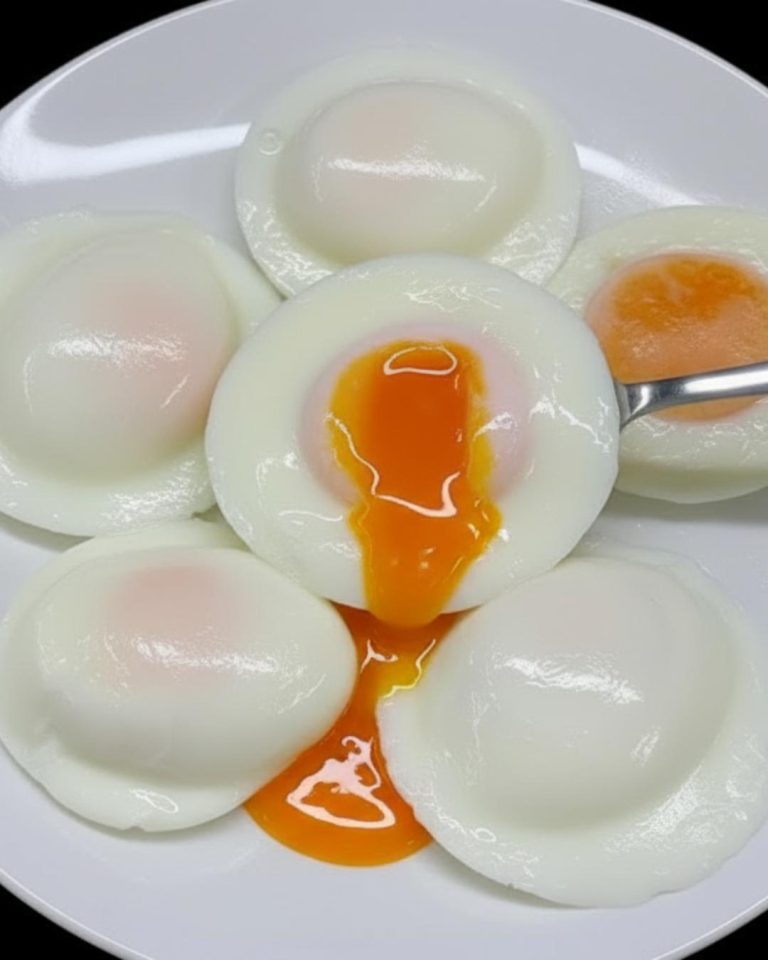Master the art of poached eggs with these three beginner-friendly techniques that deliver smooth, glossy whites and perfectly runny yolks every time. Say goodbye to broken yolks and messy whites with these professional methods you can use at home.
Ingredients
For all methods:
- Fresh eggs (as many as desired)
- Clean water for cooking
- 1 tbsp salt (for cleaning eggs)
- 1/3 tsp cooking oil (for ladle method only)
Equipment needed:
- Small bowls
- Ladle (for method 1)
- Steamer or pot with lid (for method 2)
- Microwave-safe bowl (for method 3)
Instructions
Preparing Fresh Eggs
Step 1: Check egg freshness by touch and sound. Fresh eggs have slightly rough shells with a whitish protective membrane and make no sound when gently shaken.
Step 2: Prepare a basin of clean water and dissolve 1 tablespoon of salt completely.
Step 3: Gently place eggs in salt water and soak for 5 minutes to clean and provide mild antibacterial action.
Step 4: Wipe eggshells gently with soft paper towels, then rinse once more in clean water.
Step 5: Place eggs on a plate and let them dry completely before cooking.
Method 1: Ladle Poaching Technique
Step 6: Fill a pot with enough water to cover eggs and bring to a rolling boil over high heat.
Step 7: Coat the inside of a ladle with 1/3 teaspoon cooking oil, spreading evenly to prevent sticking.
Step 8: Crack one egg directly into the oiled ladle.
Step 9: Hold the ladle just above the boiling water, letting the heat warm the egg for 30-60 seconds until it begins to set.
Step 10: Gently lower the partially set egg from the ladle into the boiling water.
Step 11: Cook for 2-3 minutes until whites are set and yolk reaches desired consistency.
Step 12: Lift the poached egg onto a plate using a slotted spoon.
Method 2: Bowl Steaming Method
Step 13: Fill small heat-proof bowls 1/3 full with clean water.
Step 14: Crack one egg into each prepared bowl.
Step 15: Bring water to boil in a steamer pot or large pot with steaming rack.
Step 16: Carefully place bowls with eggs into the steamer when water is boiling.
Step 17: Cover and steam on medium heat for 6-8 minutes depending on desired yolk consistency (6 minutes for soft, 8 minutes for firmer).
Step 18: Turn off heat and let eggs rest in residual steam for 30 seconds before removing.
Step 19: Pour out water from bowls and scoop eggs onto serving plates.
Method 3: Microwave Method
Step 20: Pour just enough water into a microwave-safe bowl to cover the bottom.
Step 21: Crack one egg into the bowl without stirring or beating.
Step 22: Microwave at 180-200°C power setting for 2-4 minutes based on preference (2 minutes for soft yolk, 3 minutes for medium, 4 minutes for firm).
Step 23: Carefully remove the hot bowl using towel or heat-resistant gloves.
Step 24: Pour out remaining water and serve immediately.
Time & Servings
Prep Time: 10 minutes (including egg cleaning)
Cook Time: 2-8 minutes (varies by method)
Total Time: 12-18 minutes
Servings: 1 egg per person (scale as needed)
Nutrition Information (Per Egg)
- Calories: 70
- Protein: 6g
- Fat: 5g
- Carbohydrates: 0g
- Vitamin D: 20% DV
- Choline: 125mg
Why This Recipe Is Good for You
Poached eggs provide complete protein with all essential amino acids while being naturally low in calories and carbohydrates. The cooking methods preserve more nutrients compared to frying, as no additional fats are needed. Eggs supply choline for brain health, vitamin D for bone strength, and high-quality protein for muscle maintenance. These gentle cooking techniques maintain the egg’s natural texture and prevent the formation of harmful compounds that can occur with high-heat frying methods.
Storage: Poached eggs are best enjoyed immediately while warm. For meal prep, store in refrigerator for up to 2 days and reheat gently in warm water.
Serving Suggestions: Perfect with avocado toast, English muffins, salads, or Asian noodle dishes. The runny yolk creates a natural sauce for vegetables or grains.
